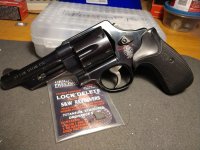Conversely, I had a M325 NG that was not reliable even with stock components. I tried new stock springs, still failed to ignite quite often.
I got a Apex XP extended firing pin, still unreliable.
I finally got a C&S extended firing pin which fixed the problem. I then went to reduced power springs and still had total reliability.
After I swapped for Wilson springs, my M629 Deluxe had some ignition issues as well, though not nearly as bad as the M325 NG. C&S firing pin fixed that one, too.
I have never had an issue with the pin getting stuck in the primer, even with my moderate 44 Mag handloads. By moderate, I mean significantly hotter than a 44 SPL but not max load for a magnum.
I'd give your gun a trigger and spring job and test fire it. If you have ignition issues, buy a C&S pin.
Or, just spend about the same money and buy an older gun with an external firing pin. Problem solved. Plus you get nicer bluing, a case hardened trigger/hammer, and no lock.

